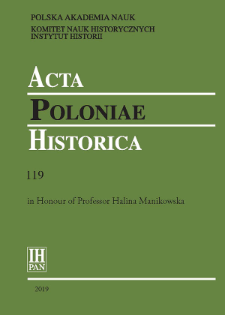- Search in all Repository
- Literature and maps
- Archeology
- Mills database
- Natural sciences
Advanced search
Advanced search
Advanced search
Advanced search
Advanced search

Object
Title: The Plague and the Wolf as Places of Memory
Subtitle:
Acta Poloniae Historica T. 119 (2019), In Honour of Professor Halina Manikowska
Contributor:
Hartzell, James : Ed. ; Institute of History of the Polish Academy of Sciences ; Polish National Historical Committee
Publisher:
Instytut Historii im. Tadeusza Manteuffla Polskiej Akademii Nauk
Place of publishing:
Description:
Type of object:
Abstract:
The essay compares two cases of very intense panic caused by the destructive forces of nature. The panic caused by the Black Death – a topic Halina Manikowska also dealt with – is presented from the point of view of its frightening memory. The long-term evolution and changes in the then-prevailing attitudes is compared to the lasting fear and panic from the menace of wolves, which also represented a mortal danger in medieval and early modern Europe; they were also feared and had to be fought against for centuries. The nature of the danger from the presence of wolves, and the ways to defend oneself against it, was however very different from the danger related to the plague.
References:
Bernardo Aldo S., ‘The Plague as a Key to Meaning in Boccaccio’s Decameron’ in Daniel Willman (ed.), The Black Death: The Impact of the Fourteenth-Century Plague (Binghampton and New York, 1982), 39–64.
Biraben Jean-Noël, Les hommes et la peste en France et dans les pays européens et méditerranéens (Paris and La Haye, 1975), vols. 1–2.
Cohn Samuel K. Jr., The Cult of Remembrance and the Black Death. Six Renaissance Cities in Central Italy (Baltimore and London, 1992).
De Blécourt Willem (ed.), Werewolf Histories (New York, 2015).
Delumeau Jean, La Peur en Occident (XIVe–XVIIIe siècles) (Paris, 1978).
Gecser Ottó, ‘Sermons on St Sebastian after the Black Death (1348–ca. 1500)’, in id. et al. (eds.), Promoting the Saints: Cults and Their Contexts from Late Antiquity until the Early Modern Period. Essays in Honor of Gábor Klaniczay for his 60th Birthday (Budapest, 2011), 261–72.
Graus František, Pest, Geißler, Judenmorde. Das 14. Jahrhundert als Krisenzeit (Göttingen, 1987).
Hecker Justin, Der schwarze Tod im vierzehnten Jahrhundert. Nach den Quellen für Aerzte und Nichtärzte bearbeitet (Berlin, 1832).
Pluskowski Aleksander, Wolves and the Wilderness in the Middle Ages (Woodbridge, 2006).
Rheinheimer Martin, ‘Die Angst vor dem Wolf. Werwolfglaube, Wolfsagen und Ausrottung der Wölfe in Schleswig-Holstein’, Fabula 36 (1995), 25–78;
Toubert Pierre, ‘La Peste Noire (1348), entre Histoire et biologie moléculaire’, Journal des Savants (Janvier-Juin 2016), 17–32.
Ziegler Philip, The Black Death (London, 1969).
Relation:
Volume:
Start page:
End page:
Detailed Resource Type:
Format:
Resource Identifier:
oai:rcin.org.pl:81802 ; 0001-6829 ; 2450-8462 ; 10.12775/APH.2019.119.02
Source:
IH PAN, sygn. A.295/119 Podr. ; IH PAN, sygn. A.296/119 ; click here to follow the link
Language:
Rights:
Creative Commons Attribution BY-ND 4.0 license
Terms of use:
Copyright-protected material. [CC BY-ND 4.0] May be used within the scope specified in Creative Commons Attribution BY-ND 4.0 license, full text available at: ; -
Digitizing institution:
Institute of History of the Polish Academy of Sciences
Original in:
Library of the Institute of History PAS
Projects co-financed by:
National Programme for the Development of the Humanities
Access:
Object collections:
- Digital Repository of Scientific Institutes > Partners' collections > Institute of History PAS > Serials
- Digital Repository of Scientific Institutes > Partners' collections > Institute of History PAS > Institute Publications
- Digital Repository of Scientific Institutes > Partners' collections > Institute of History PAS > Institute Publications > Journals
- Digital Repository of Scientific Institutes > Partners' collections > Institute of History PAS > Institute Publications > Journals > Acta Poloniae Historica
- Digital Repository of Scientific Institutes > Literature > Journals/Articles
Last modified:
Sep 22, 2023
In our library since:
Oct 1, 2019
Number of object content downloads / hits:
262
All available object's versions:
https://rcin.org.pl./publication/104468
Show description in RDF format:
Show description in RDFa format:
Show description in OAI-PMH format:
| Edition name | Date |
|---|---|
| Klaniczay, Gábor, The Plague and the Wolf as Places of Memory | Sep 22, 2023 |
Objects Similar
Manikowska, Halina (1950– )
Zarębski, Ignacy (1905–1974)
Gallewicz, Anna
Salwa, Piotr (1950– )
Picquet, Théa
McLaughlin, Martin L.
Zarębski, Ignacy (1905–1974)

 INSTYTUT ARCHEOLOGII I ETNOLOGII POLSKIEJ AKADEMII NAUK
INSTYTUT ARCHEOLOGII I ETNOLOGII POLSKIEJ AKADEMII NAUK
 INSTYTUT BADAŃ LITERACKICH POLSKIEJ AKADEMII NAUK
INSTYTUT BADAŃ LITERACKICH POLSKIEJ AKADEMII NAUK
 INSTYTUT BADAWCZY LEŚNICTWA
INSTYTUT BADAWCZY LEŚNICTWA
 INSTYTUT BIOLOGII DOŚWIADCZALNEJ IM. MARCELEGO NENCKIEGO POLSKIEJ AKADEMII NAUK
INSTYTUT BIOLOGII DOŚWIADCZALNEJ IM. MARCELEGO NENCKIEGO POLSKIEJ AKADEMII NAUK
 INSTYTUT BIOLOGII SSAKÓW POLSKIEJ AKADEMII NAUK
INSTYTUT BIOLOGII SSAKÓW POLSKIEJ AKADEMII NAUK
 INSTYTUT CHEMII FIZYCZNEJ PAN
INSTYTUT CHEMII FIZYCZNEJ PAN
 INSTYTUT CHEMII ORGANICZNEJ PAN
INSTYTUT CHEMII ORGANICZNEJ PAN
 INSTYTUT FILOZOFII I SOCJOLOGII PAN
INSTYTUT FILOZOFII I SOCJOLOGII PAN
 INSTYTUT GEOGRAFII I PRZESTRZENNEGO ZAGOSPODAROWANIA PAN
INSTYTUT GEOGRAFII I PRZESTRZENNEGO ZAGOSPODAROWANIA PAN
 INSTYTUT HISTORII im. TADEUSZA MANTEUFFLA POLSKIEJ AKADEMII NAUK
INSTYTUT HISTORII im. TADEUSZA MANTEUFFLA POLSKIEJ AKADEMII NAUK
 INSTYTUT JĘZYKA POLSKIEGO POLSKIEJ AKADEMII NAUK
INSTYTUT JĘZYKA POLSKIEGO POLSKIEJ AKADEMII NAUK
 INSTYTUT MATEMATYCZNY PAN
INSTYTUT MATEMATYCZNY PAN
 INSTYTUT MEDYCYNY DOŚWIADCZALNEJ I KLINICZNEJ IM.MIROSŁAWA MOSSAKOWSKIEGO POLSKIEJ AKADEMII NAUK
INSTYTUT MEDYCYNY DOŚWIADCZALNEJ I KLINICZNEJ IM.MIROSŁAWA MOSSAKOWSKIEGO POLSKIEJ AKADEMII NAUK
 INSTYTUT PODSTAWOWYCH PROBLEMÓW TECHNIKI PAN
INSTYTUT PODSTAWOWYCH PROBLEMÓW TECHNIKI PAN
 INSTYTUT SLAWISTYKI PAN
INSTYTUT SLAWISTYKI PAN
 SIEĆ BADAWCZA ŁUKASIEWICZ - INSTYTUT TECHNOLOGII MATERIAŁÓW ELEKTRONICZNYCH
SIEĆ BADAWCZA ŁUKASIEWICZ - INSTYTUT TECHNOLOGII MATERIAŁÓW ELEKTRONICZNYCH
 MUZEUM I INSTYTUT ZOOLOGII POLSKIEJ AKADEMII NAUK
MUZEUM I INSTYTUT ZOOLOGII POLSKIEJ AKADEMII NAUK
 INSTYTUT BADAŃ SYSTEMOWYCH PAN
INSTYTUT BADAŃ SYSTEMOWYCH PAN
 INSTYTUT BOTANIKI IM. WŁADYSŁAWA SZAFERA POLSKIEJ AKADEMII NAUK
INSTYTUT BOTANIKI IM. WŁADYSŁAWA SZAFERA POLSKIEJ AKADEMII NAUK




































